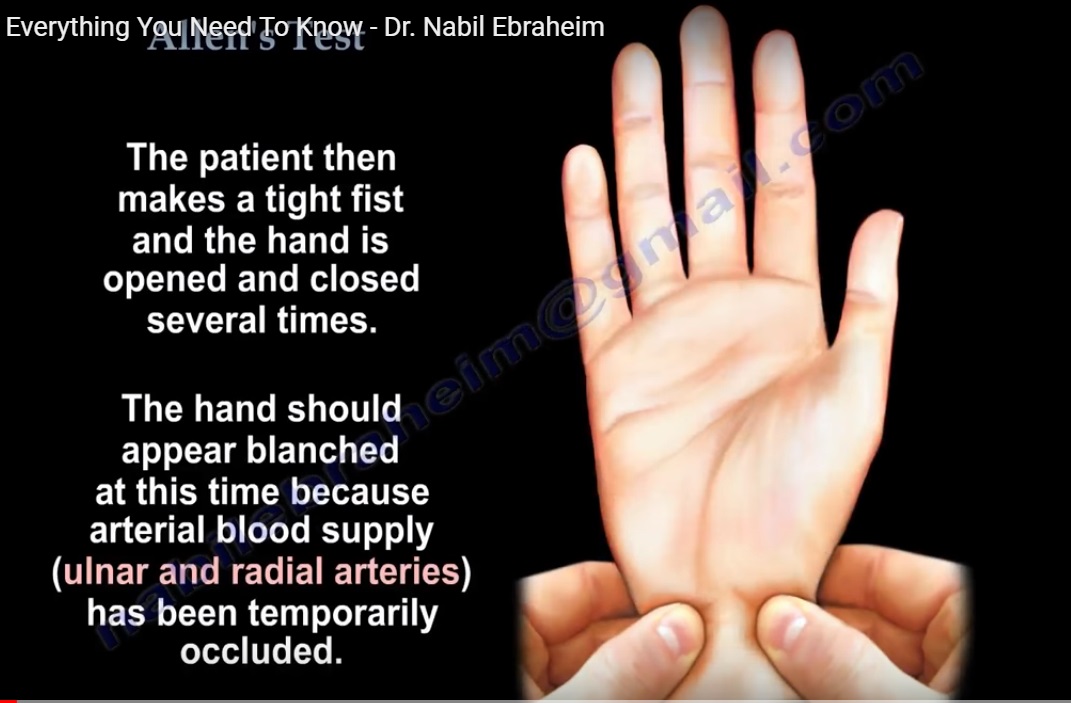Courtesy: Prof Nabil Ebraheim, University of Toledo, Ohio, USA
- The Allen’s test is done to assess the circulation of the hand.
- This test can be performed for either the ulnar or radial artery.
- The examiner applies pressure to the wrist with the thumbs, occluding the ulnar and radial arteries.
- The patient makes a tight fist and the hand is opened and closed several times.
- The hand should appear blanched at this time because the blood supply (Radial and ulnar arteries) has been temporarily occluded.
- Checking the ulnar artery: the thumb is on the ulnar artery and then released and the hand is observed for the return of capillary refill.if return of color occurs quickly, then the test is considered to show a normal, adequate circulation (Test is normal).
- Checking the radial artery: same as before, the arterial blood supply is temporarily occluded and the patient opens and closes the hand. The examiner then removes the thumb that is occluding the radial artery to check the return of the blood flow to the hand. If you see normal circulation with return of red color quickly to the hand, this means that the radial artery alone supplies adequate circulation to the hand.
- Important scenario: after temporary closure of both arteries, if the released artery does not result in return of blood flow to the hand, this means that the released artery does not provide adequate circulation to the hand.
- If you are going to operate near that temporarily occluded artery (ulnar artery), and if the temporarily occluded artery is damaged, ligated or injured during the surgery, then the other artery (Radial artery) will not have enough ability to maintain adequate circulation to the hand.
- Volar cysts ganglion entangling the ulnar artery: The volar wrist ganglion arises from the wrist joint. In the case of removal of the volar ganglion cyst of the wrist, Allen’s test to assess the adequacy of circulation from the ulnar artery if the radial artery is injured, damaged or ligated.
- This information should be known before surgery.
- Volar wrist ganglion entangling the radial artery: Do Allen’s test (temporarily occluding the radial artery) and release the thumb from the ulnar artery, you could notice that the circulation is adequate. So if the circulation is adequate, the physician will have the knowledge that there is adequate circulation present form the ulnar artery alone, in case injury occurs to the radial artery during surgery.
- If you release the pressure being placed on the ulnar artery while still maintaining pressure on the radial artery, and the color does not return quickly to the hand, then the ulnar artery alone cannot maintain adequate circulation of the hand.
- Therefore sacrificing this artery (radial artery) by injuring it, ligating it, or doing surgery on it, probably will cause problems to the circulation of the hand because the ulnar artery alone cannot provide adequate circulation to the hand.
- The radial artery is near the volar ganglion cyst entangling it, so the physician could injure the artery during the dissection of the cyst.
- If the ulnar artery does not provide adequate circulation to the hand then the circulation will be compromised.
- How do you know if the ulnar artery will provide enough circulation or not to the hand? Perform Allen’s test. In performing surgery to remove the volar wrist ganglion cyst, the risk of injuring the radial artery should be explained to the patient. other options such as nonoperative treatment or aspiration under ultrasound-guided techniques should be considered first before surgery, especially if Allen’s test shows that the ulnar artery alone is not enough to provide adequate circulation to the hand. If there is adequate blood supply to the hand, then the ganglion cyst can be removed knowing that the ulnar artery alone will provide more than enough blood supply to the hand just in case that the radial artery is compromised during surgery.

Leave a Reply